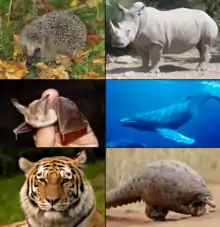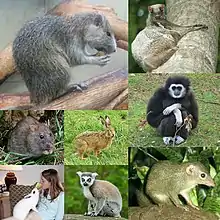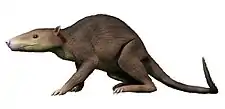Boreoeutheria
Boreoeutheria (/bɒˌriːoʊjuːˈθɪəriə/, synonymous with Boreotheria) (from Ancient Greek Βορέας, Boreas 'north wind, the North', εὐ-, eu- 'good, right' and θηρίον, thēríon 'beast', hence 'northern true beasts') is a clade (magnorder) of placental mammals. It is composed of the sister taxa
- Laurasiatheria (hedgehogs, ungulates, whales, bats, pangolins, carnivorans, and several other groups) and
- Euarchontoglires or Supraprimates (rodents, lagomorphs, primates, colugos, and some other groups).
| Boreoeutheria | |
|---|---|
 | |
| From top to right: European hedgehog, White rhinoceros, Brown long-eared bat, Humpback whale, Siberian tiger, and Ground pangolin. Representing the orders: Eulipotyphla, Perissodactyla, Chiroptera, Cetartiodactyla, Carnivora, and Pholidota. | |
 | |
| From top to left: Sunda colugo, Desmarest's hutia, Lar gibbon, European hare, Brown rat, Common treeshrew, Ring-tailed lemur, and Human playing with Rabbit. Representing the orders: Dermoptera, Rodentia, Primates, Lagomorpha, and Scandentia. | |
| Scientific classification | |
| Kingdom: | Animalia |
| Phylum: | Chordata |
| Class: | Mammalia |
| Infraclass: | Placentalia |
| Magnorder: | Boreoeutheria |
| Subgroups | |
Boreoeutheria is now well supported by DNA sequence analyses, as well as data regarding retrotransposon presence or absence. Placental mammals outside of this clade are the clades Xenarthra (anteaters, sloths, armadillos...) and Afrotheria (elephants, aardvarks, manatees...).
The earliest known fossils belonging to this group date to about 65 million years ago, shortly after the K-Pg extinction event, though molecular data suggest they may have originated earlier, during the Cretaceous period.[1] With a few exceptions[lower-alpha 1] male animals in the clade have a scrotum.[2][3] The sub-clade Scrotifera was named after this feature.[4]
Boreoeutherian ancestor
The common ancestor of Boreoeutheria lived between 100 and 80 million years ago. The boreoeutherian ancestor gave rise to species as diverse as giraffes, dogs, mice, bats, whales, and humans. The concept of a boreoeutherian ancestor was first proposed in 2004 in the journal Genome Research.[5][6] The paper's authors claimed that the genome sequence of the boreoeutherian ancestor could be computationally predicted with 98% accuracy, but would "take a few years and a lot of money". It is estimated to contain three billion base pairs.[5] Other studies have placed the common ancestor at closer to 65 million years ago.[7]
Classification
Class Mammalia
- Magnorder Boreoeutheria
- Superorder Euarchontoglires (Supraprimates)
- Grandorder Euarchonta
- Order Scandentia: treeshrews (Southeast Asia)
- Mirorder Primatomorpha
- Order Dermoptera: flying lemurs or colugos (Southeast Asia)
- Order Primates: lemurs, bushbabies, monkeys, apes (cosmopolitan)
- Grandorder Glires
- Order Lagomorpha: pikas, rabbits, hares (Eurasia, Africa, Americas)
- Order Rodentia: rodents (cosmopolitan)
- Grandorder Euarchonta
- Superorder Laurasiatheria
- Order Eulipotyphla
- Family Erinaceidae: hedgehogs and gymnures (Eurasia, Africa, extinct in North America)
- Family Soricidae: shrews (Eurasia, Africa, North America, northern South America)
- Family Talpidae: moles and desmans (Eurasia, North America)
- Family Solenodontidae: solenodons (Caribbean)
- Order Cetartiodactyla: even-toed ungulates, including pigs, hippopotamus, camels, giraffe, deer, antelope, cattle, whales, dolphins, porpoises, etc.
- Suborder Tylopoda: camels and extinct relatives
- Suborder Suina: pigs, peccaries, and extinct relatives
- Suborder Ruminantia: cattle, sheep, goats, deer, antelope, etc.
- Suborder Whippomorpha: whales, dolphins, porpoises, and hippopotamuses
- Family Hippopotamidae: hippopotamuses
- Infraorder Cetacea: whales, dolphins, and porpoises
- Order Chiroptera: bats (cosmopolitan)
- Order Perissodactyla: odd-toed ungulates, including horses, donkeys, zebras, tapirs, rhinoceroses, and Chalicotheres (cosmopolitan)
- Clade Ferae
- Order Eulipotyphla
- Superorder Euarchontoglires (Supraprimates)
Cladogram
The weakly favoured cladogram favours Boreoeutheria as a basal eutherian clade as sister to the Atlantogenata.[8][9]
| Eutheria |
| ||||||||||||||||||
Notes
- Exceptional clades whose males lack the usual boreoeutherian scrotum are moles, hedgehogs, pangolins, some seals and walruses, rhinoceroses, tapirs, hippopotamuses, and cetaceans.
References
- O'Leary, M. A.; Bloch, J. I.; Flynn, J. J.; Gaudin, T. J.; Giallombardo, A.; Giannini, N. P.; Cirranello, A. L. (2013). "The placental mammal ancestor and the post–K-Pg radiation of placentals". Science. 339 (6120): 662–667. Bibcode:2013Sci...339..662O. doi:10.1126/science.1229237. hdl:11336/7302. PMID 23393258. S2CID 206544776.
- Mills, D. S.; Marchant-Forde, Jeremy N. (2010). The Encyclopedia of Applied Animal Behaviour and Welfare. CABI. pp. 293–. ISBN 978-0-85199-724-7. Retrieved 20 June 2019.
- Drew, Liam (8 July 2013). "Why are testicles kept in a vulnerable dangling sac?". slate.com.
Between these branches, however, is where it gets interesting, for there are numerous groups, our descended but a-scrotal cousins, whose testes drop down away from the kidneys but don't exit the abdomen. Almost certainly, these animals evolved from ancestors whose testes were external, which means at some point they backtracked ... , evolving anew gonads inside the abdomen. They are a ragtag bunch including hedgehogs, moles, rhinos and tapirs, hippopotamuses, dolphins and whales, some seals and walruses, and scaly anteaters.
- Waddell; et al. (1999). "Using novel phylogenetic methods to evaluate mammalian mtDNA, including amino acid-invariant sites-LogDet plus site stripping, to detect internal conflicts in the data, with special reference to the positions of hedgehog, armadillo, and elephant". Systematic Biology. 48 (1): 31–53. doi:10.1080/106351599260427. PMID 12078643.
The name comes from the word scrotum a pouch in which the testes permanently reside in the adult male. All members of the group have a postpenile scrotum, often prominently displayed, except for some aquatic forms and pangolins (which have the testes just below the skin). It appears to be an ancestral character for this group, yet other orders generally lack this as an ancestral feature, with the probable exception of Primates.
- John Roach (25 Jan 2005). "Scientists recreate genome of ancient human ancestor". National Geographic. Retrieved 14 Feb 2015.
- Mathieu Blanchette; Eric D. Green; Webb Miller; David Haussler (2004). "Reconstructing large regions of an ancestral mammalian genome in silico". Genome Research. 14 (12): 2412–2423. doi:10.1101/gr.2800104. PMC 534665. PMID 15574820.
- "Scientists recreate genome of ancient human ancestor". MNN. 15 Feb 2013. Archived from the original on 2018-02-13. Retrieved 16 April 2019.
- Foley, Nicole M.; Springer, Mark S.; Teeling, Emma C. (19 July 2016). "Mammal madness: Is the mammal tree of life not yet resolved?". Philosophical Transactions of the Royal Society B. 371 (1699): 20150140. doi:10.1098/rstb.2015.0140. ISSN 0962-8436. PMC 4920340. PMID 27325836.
- Esselstyn, Jacob A.; Oliveros, Carl H.; Swanson, Mark T.; Faircloth, Brant C. (2017-08-26). "Investigating Difficult Nodes in the Placental Mammal Tree with Expanded Taxon Sampling and Thousands of Ultraconserved Elements". Genome Biology and Evolution. 9 (9): 2308–2321. doi:10.1093/gbe/evx168. ISSN 1759-6653. PMC 5604124. PMID 28934378.
Additional references
- Waddell, PJ; Kishino, H; Ota, R (2001). "A phylogenetic foundation for comparative mammalian genomics". Genome Inform Ser Workshop Genome Inform. 12: 141–154. PMID 11791233.
- Murphy, William J.; Eizirik, Eduardo; Springer, Mark S.; et al. (2001). "Resolution of the early placental mammal radiation using Bayesian phylogenetics". Science. 294 (5550): 2348–2351. Bibcode:2001Sci...294.2348M. doi:10.1126/science.1067179. PMID 11743200.
- Kriegs; Ole, Jan; Churakov, Gennady; Kiefmann, Martin; Jordan, Ursula; Brosius, Juergen; Schmitz, Juergen (2006). "Retroposed elements as archives for the evolutionary history of placental mammals". PLOS Biology. 4 (4): e91. doi:10.1371/journal.pbio.0040091. PMC 1395351. PMID 16515367.
- Blanchette, M; Green, E.D.; Miller, W; Haussler, D (Dec 2004). "Reconstructing large regions of an ancestral mammalian genome in silico". Genome Research. 14 (12): 2412–2423. doi:10.1101/gr.2800104. PMC 534665. PMID 15574820.
- Ma, J; Zhang, L; Suh, B.B.; Raney, B.J.; Burhans, R.C.; Kent, W.J.; Blanchette, M; Haussler, D; Miller, W (Dec 2006). "Reconstructing contiguous regions of an ancestral genome". Genome Research. 16 (12): 1557–1565. doi:10.1101/gr.5383506. PMC 1665639. PMID 16983148.
External links
- Gross, Liza (14 March 2006). "Resolving the family tree of placental mammals". PLOS Biology. 4 (4): e111. doi:10.1371/journal.pbio.0040111. PMC 1395350. PMID 20076552.
- Olson, Steve (April 2006). "Bringing back the brontosaurus". Wired.




